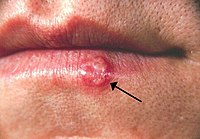
Photo from wikipedia
Abstract Cutaneous manifestations in patients with COVID‐19 infection are being increasingly reported. Several patterns have been described since the initial report by Recalcati,1 including erythematous maculo‐papular,1 urticarial,1,2 chickenpox‐like,1,3 purpuric peri‐flexural,4… Click to show full abstract
Abstract Cutaneous manifestations in patients with COVID‐19 infection are being increasingly reported. Several patterns have been described since the initial report by Recalcati,1 including erythematous maculo‐papular,1 urticarial,1,2 chickenpox‐like,1,3 purpuric peri‐flexural,4 transient livedo reticularis,5 and acro‐ischemic or chilblain‐like lesions.6,7 Herein we report the observation a new pattern with erythema multiforme‐like lesions in 4 hospitalized patients with COVID‐19 infection. All of them were women, and the mean age was 66.75 years (range 58 – 77). The mean time period between the onset of COVID‐19 symptoms to the appearance of cutaneous lesions was 19.5 days (range 16 – 24). One patient developed the skin rash during hospitalization. The remaining 3 patients had been previously discharged after clinical, analytical and radiologic improvement, and negativization of COVID‐19 PCR test. These 3 patients returned to the Emergency department consulting for skin rashes 6, 7 and 4 days after discharge, respectively. Laboratory tests at the time of skin lesions showed worsening of one or more parameters, compared to those at the time of discharge (CRP, D‐dimer and lymphocyte count). However, none of the patients presented recurrence of clinical symptoms of COVID‐19. Microbiological studies were performed in 2 patients, excluding other infectious diseases (Table 1). In all patients, skin lesions begun as erythematous papules in upper trunk, that progressively turned to erythemato‐violaceous patches with a dusky center, and a pseudo‐vesicle in the middle. Typical target lesions were observed in two patients. Lesions were markedly coalescing in the back, and then spread to the face and limbs within 1 week, without involvement of palms and soles (Figure 1). Three patient had their oral cavity examined, showing palatal macules and petechiae. Histological examination was similar in all patients, revealing a normal basket‐weave stratum corneum, and mild to moderate spongiosis in epidermis. The dermis showed dilated vessels filled with neutrophils, extravasation of red blood cells, and lymphocytic perivascular and interstitial infiltrate. Basal vacuolar changes with interface dermatitis was observed in 1 patient, and lymphocytic exocytosis in another (Figure 2). All patients were treated with systemic corticosteroids with progressive resolution of the skin lesions within 2‐3 weeks. We are facing challenging times in Dermatology. New information and cutaneous manifestations possibly related to COVID‐19 are emerging every day. Further studies are needed to evaluate whether these lesions are associated with the virus, the drug intake or any other conditions. Erythema multiforme (EM) is linked to infectious agents in 90% of the cases, while drug‐associated EM is reported in less than 10% of cases. Herpes simplex virus (HSV) and Mycoplasma pneumoniae are the main agents, but other viruses have been reported, such as Adenovirus, Coxsackie, Parvovirus B19.8 We suggest that this EM‐like or target‐like exanthem might be another pattern of exanthem associated with COVID‐19 infection. Recent articles also report targetoid lesions in exanthems of patients with COVID‐19 infection.9,10 In addition, the presence of pseudo‐vesicles and enanthem are two clues that suggest an infectious cause rather than a drug reaction. However, we cannot positively exclude the involvement of the various drugs administered to the patients. This is a first observation that will require further investigations.
Journal Title: Clinical and Experimental Dermatology
Year Published: 2020
Link to full text (if available)
Share on Social Media: Sign Up to like & get
recommendations!